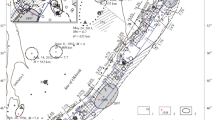Abstract
The prediction of earthquakes is a task of utmost difficulty that has been addressed in many different ways. However, an initial definition of the area of interest is needed, with adequate catalogs. In this work, different seismogenic zones proposals in the Republic of Croatia are studied, in terms of predictability. Such zones have been characterized with widely used seismicity parameters. Later, studies based on training and test sets properties as well as the quality of the data involved are carried out. The studies presented in this work analyze the prediction performance across the earthquake magnitude time series of the target seismogenic zones. Results show that specific prediction techniques could be used in some zones to improve earthquake magnitude prediction.








Similar content being viewed by others
References
Adeli H, Panakkat A (2009) A probabilistic neural network for earthquake magnitude prediction. Neural Netw 22:1018–1024
Aha DW, Kibler D, Albert MK (1991) Instance-based learning algorithms. Mach Learn 6(1):37–66
Akkar S, Glavatovic B (2010) Harmonization of seismic hazard maps for the western Balkan countries. Technical report, Science for Peace and Security Programme (NATO)
Alarifi ASN, Alarifi NSN, Al-Humidan S (2012) Earthquakes magnitude predication using artificial neural network in northern Red Sea area. J King Saud Univ Sci 24:301–313
Allen CR (1982) Responsibilities in earthquake prediction. Bull Seismol Soc Am 66:2069–2074
Asencio-Cortés G, Martínez-Álvarez F, Morales-Esteban A, Reyes J (2016) A sensitivity study of seismicity indicators in supervised learning to improve earthquake prediction. Knowl-Based Syst 101:15–30
Asencio-Cortés G, Martínez-Álvarez F, Troncoso A, Morales-Esteban A (2015) Medium–large earthquake magnitude prediction in tokyo with artificial neural networks. Neural Comput Applic pp. 1–13
Ben-Zion Y, Lyakhovsky V (2002) Accelerated seismic release and related aspects of seismicitypatterns on earthquake faults. Pure Appl Geophys 159:2385–2412
Chen S, Jiang C, Zhuang J (2016) Statistical Evaluation of Efficiency and Possibility of Earthquake Predictions with Gravity Field Variation and its Analytic Signal in Western China. Pure Appl Geophys 173:305–319
Chang C-C, Lin C-J (2011) LIBSVM: a library for support vector machines. ACM Trans Intell Syst Technol 2(3):27
Evison FF, Rhoades DA (1997) The precursory earthquake swarm in New Zealand: hypothesis tests II. J Geol Geophys 40:537–547
Friedman N, Geiger D, Goldszmidt M (1997) Bayesian network classifiers. Mach Lear 29(2-3):131–163
Gutenberg B, Richter CF (1944) Frequency of earthquakes in California. Bull Seismol Soc Am 34:185–188
Huang Q (2006) Search for reliable precursors: a case study of the seismic quiescence of the 2000 western Tottori prefecture earthquake. J Geophys Res 11:B04301
Ikram A, Qamar U (2014) A rule-based expert system for earthquake prediction. J Intell Inf Syst 43 (2):205–230
Ikram A, Qamar U (2015) Developing an expert system based on as sociation rules and predicate logic for earthquake prediction. Knowl-Based Syst, (75):pp. 87–103
Jordan TH, Jones LM (2010) Operational earthquake forecasting: some thoughts on why and how. Seismol Res Lett 81(4):571–574
Markušic S (2008) Seismicity of Croatia. NATO Science Series IV: Earth and Environmental Sciences 81:81–98
Markušic S, Herak M (1999) Seismic Zoning of Croatia. Nat Hazards 18:169–285
Martínez-Álvarez F, Reyes J, Morales-Esteban A, Rubio-Escudero C (2013) Determining the best set of seismicity indicators to predict earthquakes. Two case studies: Chile And the iberian peninsula. Knowl-Based Syst 50:198–210
Martínez-Álvarez F, Troncoso A, Morales-Esteban A, Riquelme JC (2011) Computational intelligence techniques for predicting earthquakes. Lect Notes Artif Intell 6679(2):287–294
Matsuzawa T, Igarashi T, Hasegawa AA (2002) Characteristic small-earthquake sequence off Sanriku, northeastern Honshu, Japan. Geophys Res Lett 29(11):1543–147
Matthews BW (1975) Comparison of the predicted and observed secondary structure of T4 phage lysozyme. Biochim Biophys Acta Protein Struct 405:442–451
McCulloch WS, Pitts W (1943) A logical calulus of ideas immanent in nervous activity. Bull Math Biophys 5:115–133
Morales-Esteban A, Scitovski S, Scitovski R (2014) A fast partitioning algorithm using adaptive mahalanobis clustering with application to seismic zoning. Comput Geosci 73:132–141
Morales-Esteban A, Martínez-Álvarez F, Reyes J (2013) Earthquake prediction in seismogenic areas of the Iberian Peninsula based on computational intelligence. Tectonophysics 593:121–134
Morales-Esteban A, Martínez-Álvarez F, Troncoso A, de Justo JL, Rubio-Escudero C (2010) Pattern recognition to forecast seismic time series. Expert Syst Appl 37(12):8333–8342
Ogata Y (1988) Statistical models for earthquake occurrences and residual analysis for point processes. J Am Stat Assoc 83(401):8–27
Panakkat A, Adeli H (2007) Neural network models for earthquake magnitude prediction using multiple seismicity indicators. Int J Neural Syst 17(1):13–33
Reyes J, Morales-Esteban A, Martínez-Álvarez F. (2013) Neural networks to predict earthquakes in Chile. Appl Soft Comput 13(2):1314–1328
Salzberg SL (1994) C4. 5: Programs for machine learning. Mach Learn 16(3):235–240
Sobolev GA (2007) On applicability of the RTL prognostic algorithms and energy estimation to Sakhalin seismicity. J Volcanol Seismol 1:198–211
Vere-jones D (2006) The development of statistical seismology: a personal experience. Tectonophysics 413:5–12
Yin C, Mora P (2006) Stress reorientation and LURR: implication for earthquake predictionusing LURR. Pure Appl Geophys 163:2363–2373
Yin C, Xing HL, Mora P, Xu HH (2008) Earthquake trend around Sumatra indicated by a new implementation of LURR method. Pure Appl Geophys 165:723–736
Zamani A, Sorbi MR, Safavi (2013) Application of neural network and ANFIS model for earthquake occurrence in Iran. Earth Sci Inform 6(2):71–85
Zechar JD, Jordan TH (2010) Simple smoothed seismicity earthquake forecasts for Italy. Ann Geophys 53(3):99–105
Acknowledgments
The authors would like to thank anonymous referees and journal editors for their careful reading of the paper and insightful comments that helped us improve the paper. This work was supported by the Spanish Government through research project TIN2014-55894-C2-2-R, by the Junta de Andalucía through project P12-TIC-1728, and by the Croatian Science Foundation through research grants IP-2016-06-8350.
Author information
Authors and Affiliations
Corresponding author
Additional information
Communicated by: H. A. Babaie
Rights and permissions
About this article
Cite this article
Asencio–Cortés, G., Scitovski, S., Scitovski, R. et al. Temporal analysis of croatian seismogenic zones to improve earthquake magnitude prediction. Earth Sci Inform 10, 303–320 (2017). https://doi.org/10.1007/s12145-017-0295-5
Received:
Accepted:
Published:
Issue Date:
DOI: https://doi.org/10.1007/s12145-017-0295-5




